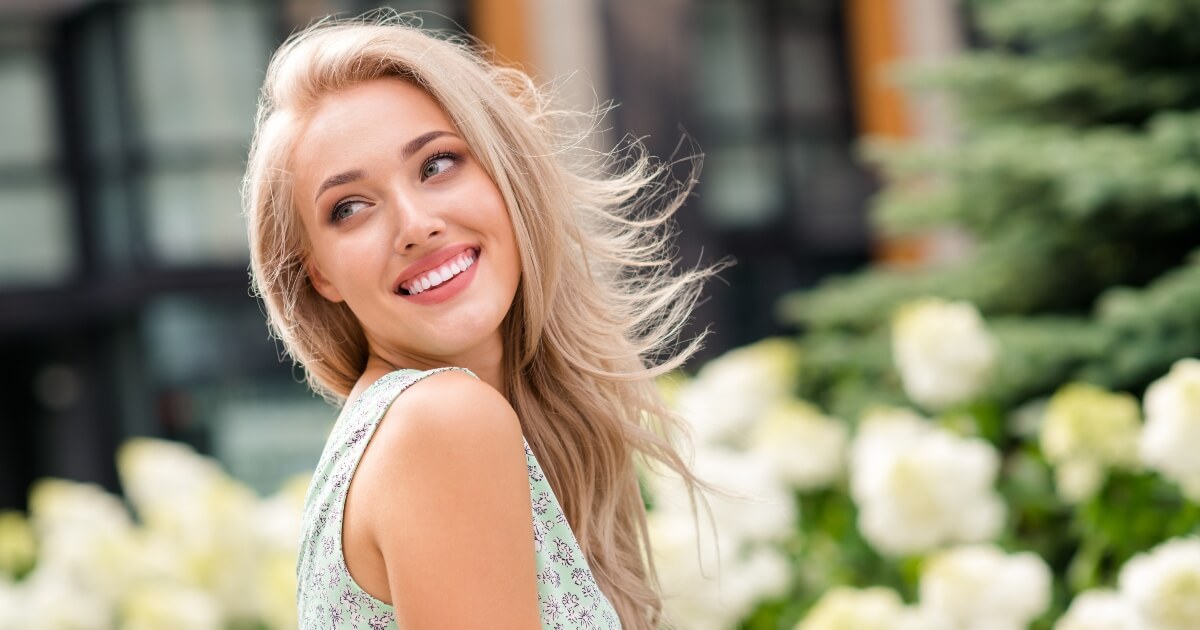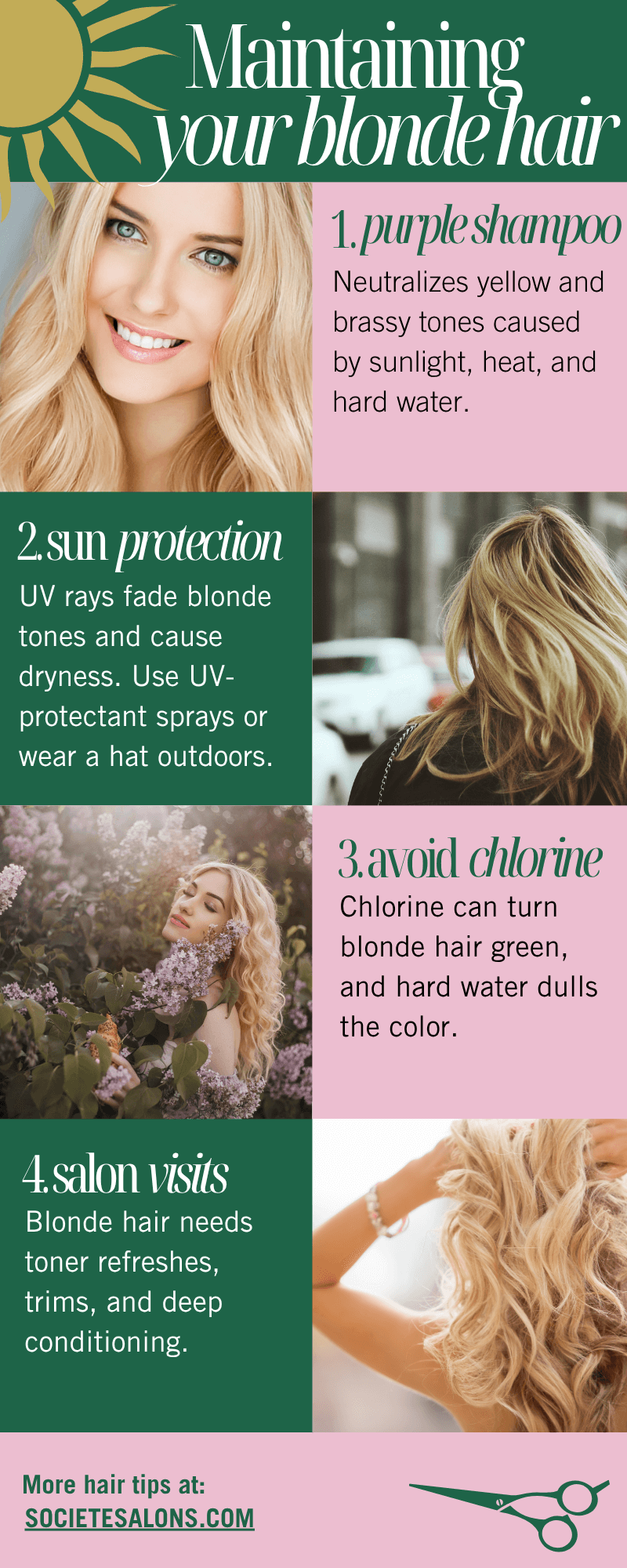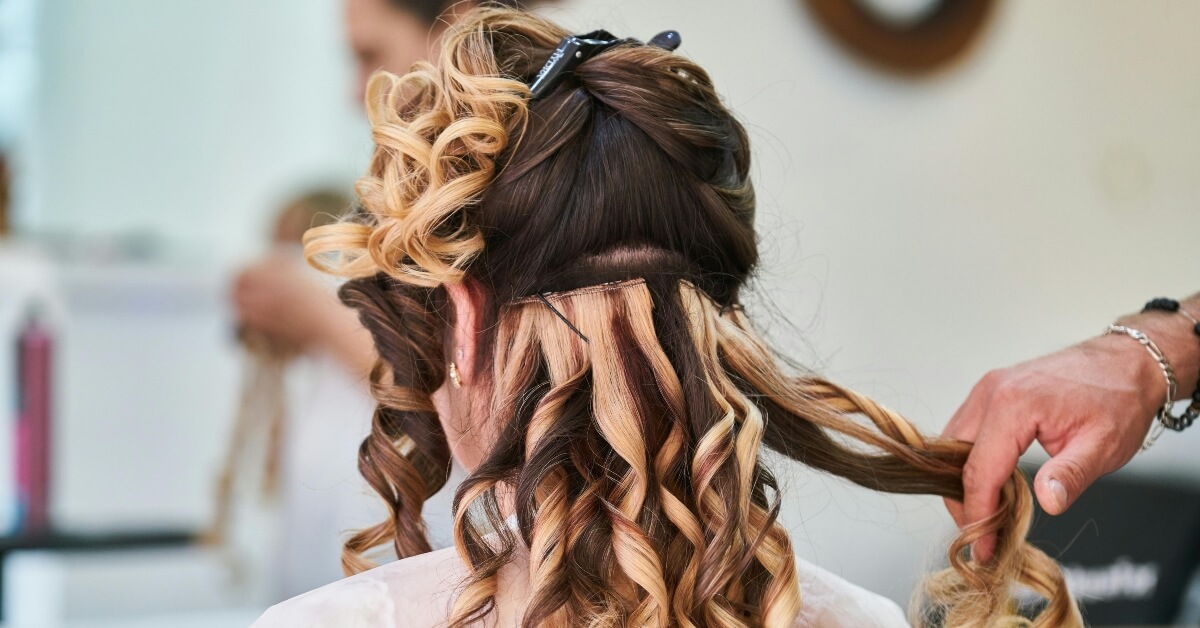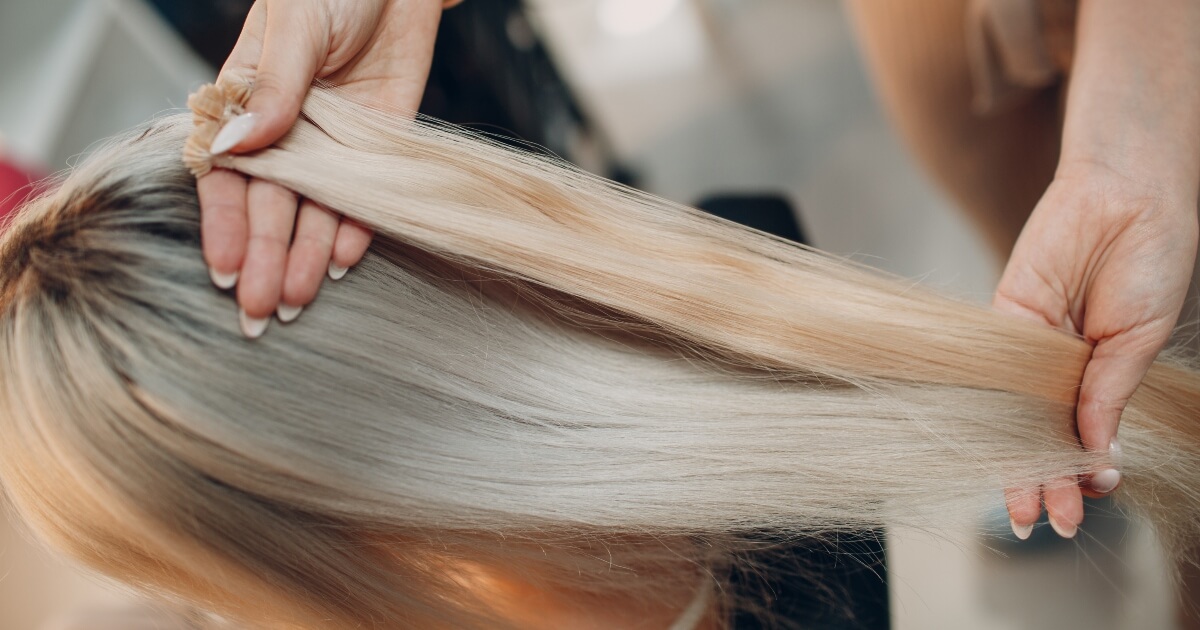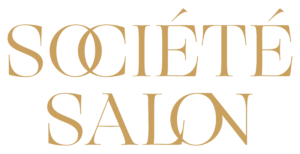Do you know why some people have blonde hair and others don’t? Do you understand the process of dyeing hair blonde? Do you know how blonde hair has been perceived throughout history?
In this highly detailed blog, we reveal dozens of blonde hair facts, including facts about why some people have blonde hair, the different shades of blonde, how to maintain blonde hair, and much more.
If you’re considering going blonde, the experienced hair stylists at Societe Salon know how to deliver the color you’ve been dreaming of. Book your appointment today and let’s get your transformation underway.
41 Facts About People Who Have Blonde Hair
Genetic Facts
- Less than 5 percent of the world’s population has naturally blonde hair.
- Blonde hair is caused by mutations in the MC1R gene.
- Natural blondes have up to 150,000 hair strands. Brunettes have about 100,000 and redheads have about 90,000.
- Blonde hair strands are finer than dark hair strands.
- The same genes that create blonde hair often cause blue eyes.
- Blonde hair contains very little eumelanin and small amounts of pheomelanin.
- Pregnancy can permanently darken blonde hair due to hormonal changes.
- Sun exposure can naturally make blonde hair lighter.
- Hard water can gradually change blonde hair color over time.
- Chlorine from swimming pools can change blonde hair color.
- Some medications can change blonde hair color.
Fun Facts About Blonde Hair Across the World
- Some regions of Finland, Sweden and Norway have populations up to 80 percent blonde.
- About 40 percent of American women have blonde hair at any given time (mostly artificial).
- About 4 percent of Australia is natural blonde.
- Historically, blonde hair used to be much more common. Population movement has lowered the percentage.
- Northern and Eastern Europe have the highest concentrations of natural blondes.
- Most natural blondes are found in Scandinavian countries.
Facts About Blonde Hair Colors
- Platinum blonde is the rarest natural shade.
- There are 5 main types of blonde hair: platinum, ash, golden, strawberry and dirty blonde
- Strawberry blonde sits between blonde and red hair.
- Ash blonde has gray undertones.
- Golden blonde has warm yellow and honey undertones.
- Dirty blonde is a mix of brown and blonde.
- Dirty blonde gets lighter in summer and darker in winter.
- Scandinavians tend to have cooler, ashier blonde tones.
- Mediterranean populations often have warmer, golden blonde undertones.
Historical & Cultural Facts About Blonde Hair
- Ancient Greeks connected blonde hair with their gods Aphrodite and Apollo.
- Greeks used potash water and yellow flower petals to dye hair blonde.
- Wealthy Greeks wore blonde wigs made from hair of captured Germanic tribes.
- Romans initially thought blonde hair was exotic and barbaric.
- Blonde hair later became fashionable among Roman elites.
- Roman women used saffron dyes to achieve blonde hair.
- The Venus de Milo and other classical sculptures featured blonde hair.
- Ancient Egyptian art occasionally depicted blonde hair on foreigners and divine figures.
Hair Care & Maintenance Facts
- Blonde hair fades faster in sunlight than other hair colors.
- UV rays break down blonde hair color molecules, causing brassiness.
- Chlorine can turn blonde hair green.
- Hard water contains minerals that build up on blonde hair and make it look dull.
- Blonde hair shows damage more easily than dark hair due to light reflection.
- Heat styling causes more damage to blonde hair than dark hair.
- Chemical processing is especially harsh on fine blonde hair.
What Creates Blonde Hair?
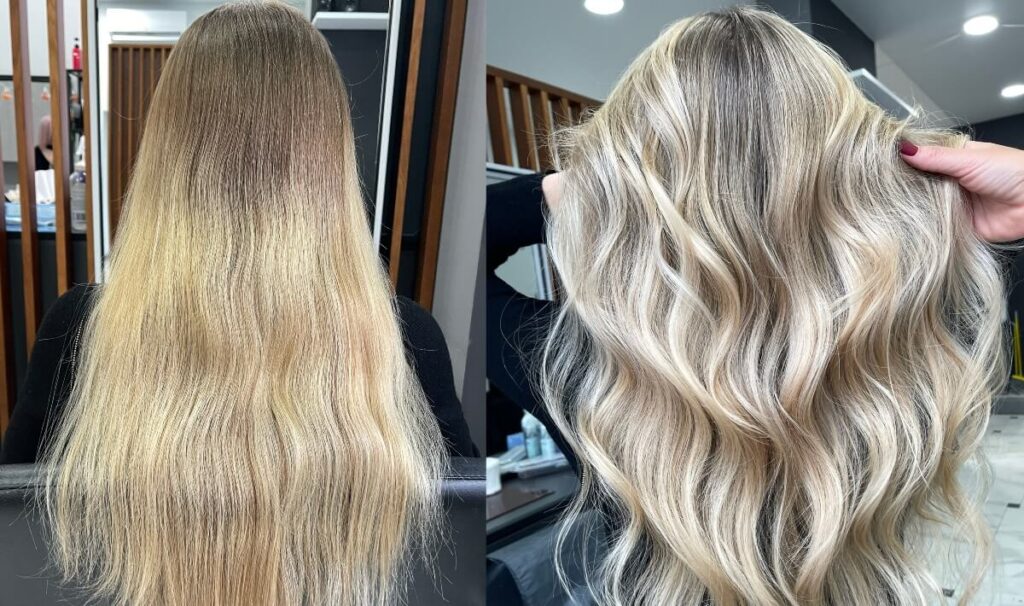
Find out the science behind blonde hair, and why some people have it while many others don’t.
Genetics Behind Blonde Hair
The main culprit with blonde hair is melanin, specifically eumelanin and pheomelanin. Eumelanin creates brown and black colors while pheomelanin creates red and yellow. People with a small amount of pheomelanin often have lighter, golden or ashy-colored hair.
Melanin levels are regulated by the MC1R gene. Some mutations in this gene will decrease the amount of dark pigment in your hair. Your parents pass these mutations down to you.
The same set of genes that form blonde hair can also make your eyes blue.
How Rare Is Natural Blonde Hair?
Less than five percent of the world population has naturally blonde hair.
Most natural blondes are in Northern and Eastern Europe. Countries like Finland, Sweden and Norway have the highest percentages of blonde-haired people – sometimes up to 80 percent of the population.
Only about 4-5 percent of the U.S. population is naturally blonde. About 40 percent of American women have blonde hair though, because many dye their hair that color.
About 4 percent of Australians are natural blondes. Many people who moved to Australia came from countries in Northern Europe.
Blonde hair used to be more common. It’s become less common because of the environment and population movement.
What Happens to Blonde Hair as People Get Older?
Most people with blonde hair don’t keep it their whole lives.
Your Hair Gets Darker Many kids have light blonde hair. Their bodies haven’t started making much melanin yet. As they get older, they produce more melanin. Their hair gets darker.
Kids with platinum blonde hair might end up with light brown hair by high school. This usually happens during the teenage years.
Pregnancy Changes Hair Color Pregnancy can make blonde hair darker because your hormones change. Some women’s hair goes back to its original color after having the baby. Others keep the darker hair permanently.
Your Environment Changes Your Hair Too Sun can naturally bleach your hair. Winter weather makes it look darker. Hard water from your shower can gradually change your hair color too.
Chlorine from swimming pools is also a problem. Some medications alter your hair color over time. Pollution in your environment can change your hair color as well.
All these factors build up over years and turn your hair a darker shade.
Hair Gets Darker Before It Goes Gray Hair usually gets darker before it turns gray. Your cells don’t produce as much melanin as you age. Your hair might get darker for a while before you start seeing gray hairs.
There are Several Different Shades of Blonde Hair
Different Types of Natural Blonde Hair
Natural blonde hair falls into these categories:
- Platinum Blonde: The lightest you can get naturally. It looks almost white or silver. You don’t see this very often. Most people with natural platinum blonde also have fair skin.
- Ash Blonde: Has gray tones that give it a muted look. If you have cool skin, this color probably looks great on you. Common among Scandinavians. People with this natural color often have skin that looks like porcelain.
- Golden Blonde: Has warm yellow and honey tones. Often what people think of when they picture blonde hair. More common among people who live along the Mediterranean.
- Strawberry Blonde: Sits right between blonde and red. Often peach or copper-colored. You don’t see this very often.
- Dirty Blonde: A mix of brown and blonde. Gets lighter in the summer and darker in the winter.
Unsure what shade is right for you? The elite hair stylists at Societe Salon have helped countless clients determine the right shade of blonde.
You can book your appointment online today. Let’s help you achieve Beauty with Confidence.
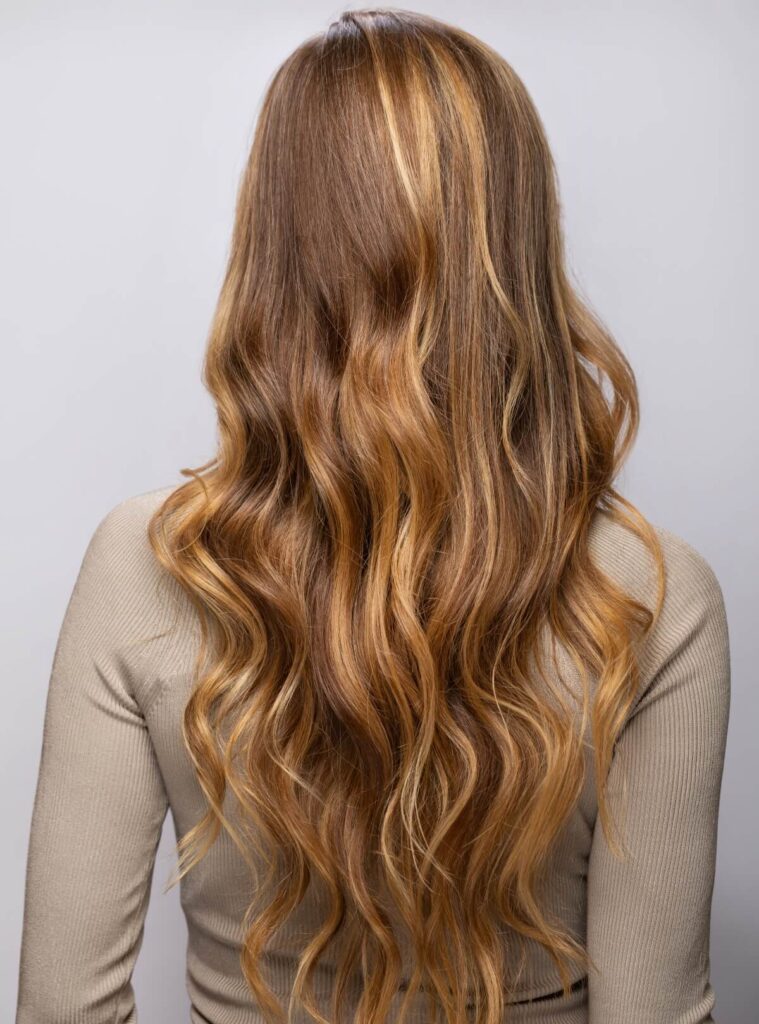
Do Blondes Really Have More Hair?
Natural blondes usually have way more hair strands than other people:
- Brunettes: about 100,000 hair strands
- Redheads: around 90,000 strands
- Blondes: up to 150,000 individual strands
Blonde hair strands are thinner than strands of dark hair. That’s why the body creates more hair follicles.
Advantages of Fine Blonde Hair
These are some of the advantages of having fine blonde hair:
- Your hair looks fuller even though each strand is thinner.
- It moves around more when you style it.
- Fine hair is better at holding curls.
What are the Downsides of Fine Blonde Hair?
Unfortunately, there are some problems with this type of hair:
- Blonde fine hair breaks easier than dark, heavy hair.
- Heat styling is more damaging.
- Chemical processing can be damaging, so stylists need to be especially careful.
- Stylists have more surface to work with when coloring (dyeing or bleaching) blonde hair.
- Damage is more easily visible with fine hair.
Blonde Hair Throughout History
Blonde hair has always been something unique in cultures across history for thousands of years.
Ancient Greeks connected blonde hair with their gods:
- Figures like Aphrodite and Apollo had golden hair in paintings
- The Greeks saw blonde hair as a representation of beauty and power
- Greeks found ways to lighten hair, such as mixing potash water with yellow flower petals
- Affluent Greeks wore blonde wigs made from Germanic tribes that they conquered
Meanwhile, Romans initially thought that blonde hair was from northern European tribes. This changed, however, when blonde hair became the rage among the Roman upper class, who:
- Adorned their hair with saffron dyes
- Bathed for hours in sunlight wearing protective hats
- Tanned their hair
Blonde hair became a status symbol in Ancient Rome. Foreigners and gods were sometimes shown in Egyptian art with blonde hair.
How Did Hollywood Redefine Blonde Hair?
Hollywood made blonde hair incredibly popular and desirable.
Jean Harlow
She was the first high-profile blonde. Unfortunately, she needed a lot of chemical processing to achieve her platinum blonde hair, and this was highly damaging. At the time, a lot of women went to salons requesting the same look. This started the trend of women wanting artificial blonde hair.
Marilyn Monroe
Marilyn Monroe’s platinum blonde hair became intertwined with glamour in the 1950s and 1960s. Most people do not know that Monroe was a brunette.
Alfred Hitchcock’s Preferences
Alfred Hitchcock preferred blonde actresses, like Grace Kelly and Kim Novak. He felt this hair color could contract innocence and worldliness.
Film companies found that blonde actresses looked better under heavy lighting, as their hair did a better job reflecting light.
Unfortunately, the popularity of blonde hair started the “dumb blonde” stereotype. However, many blonde actresses only went along with this stereotype to further their careers.
Modern Trends with Blonde Hair
Madonna defined blonde hair as edgy during the 1980s. She showed people that constantly changing blonde hairstyles could be bold.
The 1990s brought us the supermodel blonde (Pamela Anderson, Claudia Schiffer, etc.). The decade was defined by supermodel blondes who looked natural.
Social Media’s Influence
Social media apps like Instagram and TikTok enable people to quickly learn about new blonde hairstyles and methods for going blonde. Trends like “bronde” and other balayage methods can go viral on social media.
Today, going blonde is all about maintaining the health of your hair and tailoring the color to your skin tone and preferences.
Debunking Myths About People with Blonde Hair
There are so many myths about blonde hair.
Blonde Hair and Blue Eyes Always Go Together
One of the biggest myths out there is that blondes almost always have blue eyes. Blonde hair and blue eyes are a common combination, but you can be blonde with:
- Blue eyes
- Green eyes
- Hazel eyes
- Gray eyes
The combination of blonde hair and blue eyes is rare. You need to inherit the genes from both of your parents.
Most blondes have brown or hazel eyes. Blue eyes are more common in places like Northern Europe.
You don’t need blue eyes to go blonde. Your stylist will help you choose the right blonde color to match your eyes.
The ‘Dumb Blonde’ Stereotype
The most harmful blonde myth is the “dumb blonde” stereotype. This started in Hollywood during the 1930s and 1940s. Marilyn Monroe, and other actresses, had roles where the women were stunning but not ery intelligent.
The majority of these “dumb blonde” actresses were smart women. They exploited the stereotype because it was profitable for their careers. Unfortunately, the misconception still lingers.
What Studies Say About Intelligence Among Blondes
There have been several studies that have tested intelligence and hair color. None have found any correlation between blonde hair and intelligence. A person’s intelligence is determined by genetics, education and environment, not their hair color.
If you do worry about not being taken as seriously as you’d like because of blonde hair, remember that ability and intelligence aren’t linked to hair color.
Blonde Hair and Attractiveness: What the Research Says
Some research shows men prefer to date women with blonde hair. However, these preferences vary by:
- Geographic location
- Culture
- Personal experience
- Personal taste
Some research has implied that blonde women may make a little bit more money in some careers. These studies are disputed, however, and do not control for many other variables that affect a person’s earnings.
What one person finds good looking, another may not. Hair color is just one small item on a list of many features that play into what someone else finds attractive.
You should not decide to go blonde simply because you think others will find it more attractive. Go blonde if you want to, not because you think it’s going to make you more attractive than others.
What Your Stylist Wants You to Know
If you’re thinking about going blonde, there’s a lot you should know before you go for it.
It’s a Process
It’s not as simple as picking a color and slapping it on. There’s a lot to consider.
The consultation phase: Before getting to work, a reputable stylist will want to know:
- Your hair history (past treatments, colors)
- Your maintenance and lifestyle
- Your skin tone and eye color
- Your goals
Skin color: The wrong blonde shade can make you look pale. Cool skin types are a better match for platinum blonde hair. Warm skin types go better with honey blonde or golden blonde.
Hair health test: Your stylist needs to find out whether your hair is healthy enough to withstand the bleaching process. They’ll check:
- Current state of your hair
- History of chemical treatments
- Natural porosity and texture of your hair
- Amount of lightening you’re going to need
Realistic expectations: You can’t always get the blonde color you want in one sitting, especially if you have very dark hair. Your stylist will let you know what can be accomplished and how long it’s going to take.
The Bleaching Process Explained
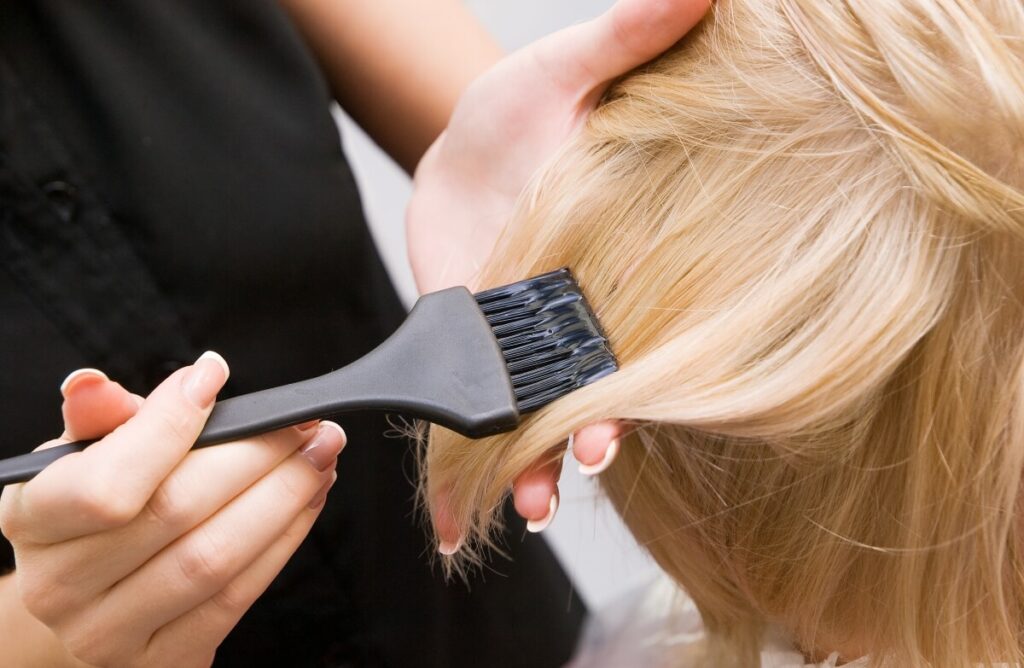
When you understand how this works, you’ll know what you’re in for.
How bleaching works: Bleach breaks down the melanin (color pigments) in your hair. It’s a chemical reaction that removes color, not applies it. The bleach cuts through your hair cuticle and destroys the melanin molecules inside.
Why a few sessions may be required? Your hair only has so much that it can handle at once. Trying to go from dark brown to platinum blonde in a single session will likely leave your hair severely damaged or broken.
Most stylists prefer to lighten hair incrementally:
- Session 1: Lift to medium brown/dark blonde
- Session 2: Lift to light blonde
- Session 3: Get the final blonde color
Potential damage: Bleaching is inherently damaging to the hair. It removes moisture, protein and color. A good stylist can minimize damage by:
- Using the correct bleach strength
- Being careful with processing time
- Using bond-building treatments
- Taking breaks in between sessions
Keeping Blonde Hair Healthy
Once you go blonde, you’re going to need to take several steps to maintain it and you’re your hair healthy, including:
- Using purple shampoo to protect against brassiness
- Deep conditioning treatments
- Using heat protectant
- Applying UV protective sprays
Professional touch-ups: Most people who go blonde need professional maintenance every 6-8 weeks. These include:
- Touch-ups at your roots as your natural hair grows out
- Toner treatments for color replenishment
- Deep conditioning treatments
- Cutting off damaged ends
Blonde hair is more susceptible to damage from:
- Sunlight (can cause brassiness and fading)
- Chlorine (can turn blonde hair green)
- Hard water (can cause mineral buildup)
- Heat styling (does more damage to processed hair)
Your stylist will give you precise instructions on how to maintain your shade.
Cost Factors Involved in Getting Blonde Hair
It costs more than most people expect to go blonde and maintain it.
Initial Investment
The cost is going to vary based on:
- Original hair color
- Specific blonde color
- Hair thickness and length
- Geographical location
- Salon prices
More complex color corrections may cost more.
Annual costs: Many blondes spend $1,500-3,000 annually on maintenance. This doesn’t include at-home products.
Getting Blonde Hair at a Salon or at Home
Always get your initial blonde done professionally. Color corrections cost more than doing things right the first time. Then you will just need to use purple shampoo and deep conditioner to maintain your color.
Make sure your stylist clearly explains the cost and necessary maintenance. Otherwise get yourself a new stylist.
Blonde Hair Has Unique Needs You Need to Know
Blonde hair has specific issues. Being aware of these allows you to more effectively care for your blonde hair.
Sun sensitivity and fading:
Blonde hair fades faster in the sun than dark hair. The UV light breaks down the color molecules, causing your blonde to become brassy or flat.
You’re going to notice fading much more in the summer or when you are outdoors a lot. However, even short time outdoors will start to change your color.
Chlorine
Chlorine will turn blonde hair green or give it an odd color. You will need to use special shampoos to protect your hair if you are often in the pool. For example, wear a swim cap.
Hard water
Hard water contains minerals that build up on blonde hair over time. The buildup gives your blonde hair a dull look and can change the color, often making it darker and brassier.
Brassiness
People who go blonde often complain about brassiness. This happens when:
- Your hair goes through heat and UV light
- Water minerals damage your hair
- The toner wears off
- Your natural undertones start to come through
Purple shampoo can counteract these problems.
Maintaining Blonde Hair Throughout Your Life
There are many reasons why it’s tough to keep blonde hair throughout your life.
Pregnancy
Women often want to know if they can bleach their hair while they’re pregnant. Most doctors say it’s fine after the first trimester, but you should always check.
Your hair texture can change during pregnancy, which can make it more difficult to change your hair color. Your hair stylist can adjust their bleaching method to make up for this.
Blonde Hair as a Teenager
A teen who had lighter hair as a child often sees it get darker as they age. This is completely normal and happens because hormone changes affect melanin.
Menopause and Blonde Hair
Menopause affects your hormones, which can make your hair more resistant to changing color. It can also take longer to process hair on someone who has gone through menopause.
Menopause changes the texture of your hair. Your stylist may need to alter their technique or use different products to achieve a blonde color.
Aging Gracefully with Blonde Hair
Blonde hair can soften facial features as you age. Having said that, getting a pale blonde color can make your face look washed out.
Most women see their hair gradually darken as they age. That is why older women often go for honey blonde over platinum blonde.
How Your Health Affects Your Blonde Hair
Your overall health affects your blonde hair’s appearance and texture. Understanding how health issues, diet, and hair color are connected allows you to maintain your blonde hair’s attractiveness while also addressing any underlying health issues.
There are numerous health conditions that will impact your blonde hair in surprising ways.
Thyroid Problems and Hair Color
Thyroid disease also affects hair color and texture. An underactive thyroid (hypothyroidism) can make blonde hair lose its shine and become limp. It can also darken your hair a bit or make it lose its shine.
An overactive thyroid (hyperthyroidism) can make your hair thin and brittle. Blonde hair is already thin hair, so thyroid disease can worsen breakage.
If you notice extreme changes in the growth rate, texture, or appearance of your blonde hair, talk to your doctor about having your thyroid levels tested.
Hormonal Changes
Pregnancy’s effect on blonde hair has already been discussed, but other hormonal changes are relevant too. Menopause can make blonde hair coarser and more resistant to processing. Some women find that their natural blonde hair darkens at menopause.
PCOS (polycystic ovary syndrome) can also affect hair color and texture. PCOS hormonal imbalances sometimes cause the hair to darken or change texture.
Birth control pills sometimes affect hair color to a certain degree. Some women notice their blonde hair darkening somewhat or changing tone when they start or stop birth control.
Nutritional Factors That Affect Blonde Hair
Your diet directly affects the way your blonde hair looks and grows.
Protein Deficiency and Blonde Hair: Hair is made up of mostly protein, and a deficiency of it can really hurt your blonde hair. Protein deficiency will make blonde hair thin, weak, and brittle.
Blonde hair is already finer than other hair colors to start with, so protein deficiency shows up earlier. You might notice more hair than normal falling out or breaking off.
Good sources of protein are lean meat, fish, eggs, beans, and dairy products. If you’re vegetarian or vegan, make sure you’re obtaining complete proteins from a wide range of sources.
Iron Deficiency Problems: Iron deficiency is one of the most common nutritional problems that afflict hair. Iron deficiency can make your blonde hair thin, dull, and slow-growing.
Women are especially prone to develop iron deficiency due to menstruation. If your blonde hair is limp or you are losing more hair than usual, get your doctor to check you for iron levels.
Red meat, spinach, lentils, and cereals fortified with iron have iron in them. Vitamin C helps in the absorption of iron in the body, so consume oranges or tomatoes together with iron-rich foods.
Vitamin Deficiencies that Result in Unhealthy Blonde Hair
There are several vitamin deficiencies which make blonde hair look unhealthy.
B Vitamin Deficiencies: B vitamins, especially biotin (B7) and B12, are vital for the health of blonde hair. Biotin deficiency can cause hair thinning and make blonde hair dull.
B12 deficiency is common in vegetarians and older people. B12 deficiency can cause hair loss and make existing blonde hair weak and brittle.
You can obtain B vitamins from meat, fish, eggs, milk products, and leafy vegetables. B-complex supplements benefit some people, but check with your doctor first.
Vitamin D and Hair Health: Vitamin D levels that are too low affect hair quality and growth. Many people don’t have enough vitamin D, especially in the winter.
Blonde hair grows more slowly and looks less healthy with a vitamin D deficiency. It can also result in hair loss.
Your body synthesizes vitamin D from the sun. Nonetheless, you can also get it from fatty fish, fortified foods, and supplements.
Medical Treatments That Can Alter Blonde Hair
Some medical treatments and medications can influence the color of your blonde hair.
Chemotherapy and Hair Color: Chemotherapy typically causes hair loss, but when hair grows back, it can be a different color. Some people who were blonde before chemo find their hair grows back darker or with a new texture.
This is because chemo affects the hair follicles and can change how they make pigment. The change can be permanent or temporary.
Drugs That Affect Hair Color: Some medications change hair color after prolonged use. Blood thinners, antidepressants, and antibiotics can darken blonde hair or change its tone.
If you start a new medication and notice that your blonde hair color or texture is changing, let your doctor know. Sometimes the effects are reversible if you stop taking the medication.
Hormone Replacement Therapy: Hormone replacement therapy (HRT) can affect the texture and color of hair. Blonde hair can become slightly darker or its texture changed when women start HRT.
This is usually because HRT changes your hormone levels, which can affect the production of melanin in your hair follicles.
When to See a Doctor About a Change in Your Hair
If you see a sudden change in the appearance, texture or growth rate of your blonde hair, you might have a health problem.
You should definitely see your doctor if you notice:
- Rapid hair loss or thinning
- Sudden color changes you can’t explain
- Coarse or brittle hair texture
- Bald patches or losing your hair unevenly
Your doctor can check for thyroid problems, issues with your diet or changes in your hormones.
If you want to take care of your blonde hair, one of the best things you can do is try to maintain good overall health. Eating well, managing stress and quickly dealing with health problems can help keep your blonde hair looking its best.
Frequently Asked Questions on Blonde Hair
How Would You Know if a Person is Naturally Blonde?
Look at their eyebrows and body hair. Natural blondes usually have paler-colored eyebrows and body hair that matches their skin tone. Their roots will also match the color of the rest of their head. Natural blondes have uneven-colored hair. Some strands are lighter colored than the rest of the hair.
What’s the Rarest Natural Blonde Color?
Platinum blonde is the rarest natural color. Most people who have this hair color weren’t born with it. Strawberry blonde is also a relatively uncommon natural shade of blonde.
Can You Go Blonde Without Damaging Your Hair?
You can’t avoid all damage when going blonde. Elite stylists can minimize the damage by with bond-building treatments. You also need to know that the lighter your starting color, the less damage there’s likely to be.
How Long Does Blonde Hair Color Last?
About six to eight weeks. After that you need a touch-up. However, this can be longer or shorter, depending on how often you’re exposed to the sun and how often you wash your hair.
Why Does Blonde Hair Become Brassy?
Because the toner has faded. This could be caused by heat from the sun or styling tools, along with hard water and possibly pollution.
Is Blonde Hair More Difficult to Care for?
Yes, blonde hair needs more care, because it’s more likely to get damaged. You’re going to need to use purple shampoo and get regular touch-ups at the salon.
Societe Salon’s expert stylists are here to help you get the blonde hair you’ve been envisioning. Schedule your appointment and let’s get you the beautiful hair color and style you deserve.
